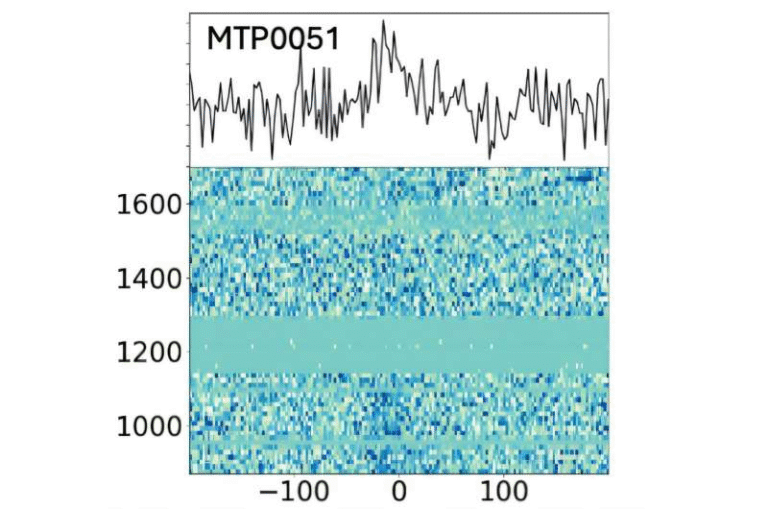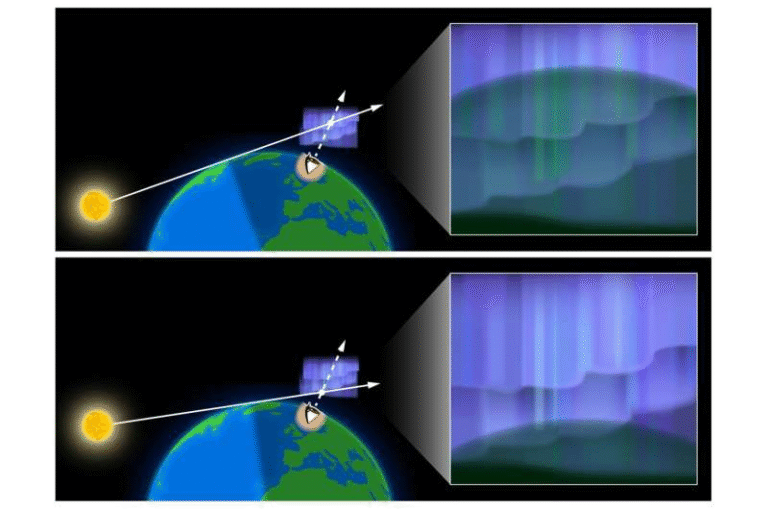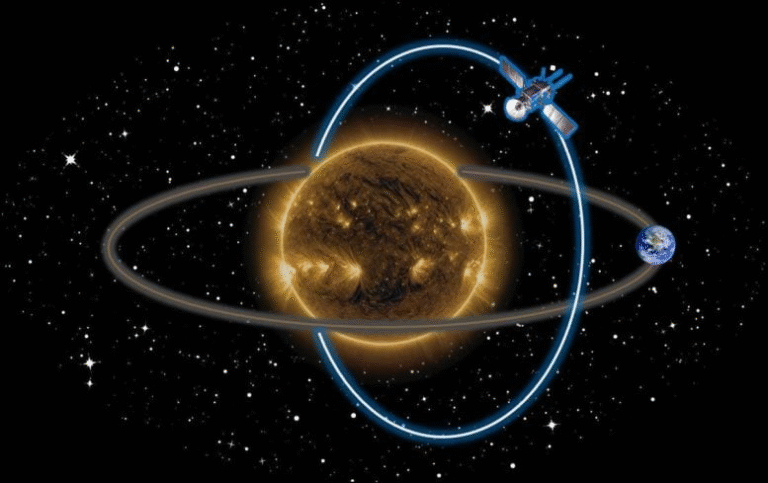Scientists Finally Discover Why It Rains on the Sun

For decades, scientists have observed a strange and beautiful phenomenon happening high above the Sun’s surface — something they call coronal rain or solar rain. It’s not water falling from the sky like on Earth, but streams of cool plasma that condense in the Sun’s blazing outer atmosphere and fall back along powerful magnetic field lines. The mystery that puzzled researchers for years was simple yet profound: how could such cool, dense “raindrops” form so quickly in a region millions of degrees hot?
Now, a new study led by scientists from the University of Hawai‘i Institute for Astronomy (IfA) has provided a breakthrough answer. The research, led by Luke Fushimi Benavitz, a first-year graduate student, alongside astronomer Jeffrey Reep, and co-authors Lucas A. Tarr and Andy S.H. To, reveals that the secret behind this solar rain lies in the changing composition of the Sun’s outer layers during solar flares. Their findings were published in The Astrophysical Journal under the title “Spatiotemporal Low First Ionization Potential Abundance: A Catalyst for Coronal Condensation.”
What Exactly Is Solar Rain?
Before diving into the discovery, it’s helpful to understand what solar rain actually is. The Sun’s outermost layer, called the corona, is made up of superheated plasma — a charged soup of particles at temperatures exceeding 1 million degrees Celsius. Despite being unimaginably hot, small patches of this plasma can suddenly cool and condense into denser clumps. These blobs then fall back toward the Sun’s surface along curved magnetic field lines, creating the visual effect of glowing raindrops cascading down the solar atmosphere.
Astronomers have observed this phenomenon for decades through missions such as NASA’s Solar Dynamics Observatory (SDO) and other space telescopes. Yet the exact cause of how the plasma cooled so rapidly remained one of the great unanswered questions in solar physics.
The Long-Standing Mystery
For years, solar models tried to replicate this process, but the math never quite worked out. Traditional theories assumed that the elemental composition of the corona — that is, the abundance of different atoms like iron, magnesium, silicon, and oxygen — stayed constant over time and space. Under those assumptions, the cooling times required for coronal rain were too long, stretching over hours or even days. But in reality, solar rain often forms within minutes after a flare erupts.
This mismatch between model predictions and real observations hinted that something crucial was missing from the equations.
The New Explanation
The breakthrough came when Benavitz and his colleagues decided to challenge a key assumption in solar physics: that elemental abundances don’t change. Their new model allows the composition of the plasma to vary with time and location, especially during solar flares when the Sun’s magnetic fields unleash enormous amounts of energy.
By incorporating these dynamic abundances, they discovered that certain low First Ionization Potential (low-FIP) elements, such as iron, magnesium, and silicon, play a huge role in how quickly plasma cools. When these low-FIP elements become locally concentrated in certain parts of the corona, they dramatically increase the plasma’s ability to radiate heat away. This leads to a runaway cooling process — a sudden drop in temperature that causes the plasma to condense into “rain.”
In simpler terms: when elements like iron build up in one spot, that region cools faster, condenses, and starts to fall back down — producing solar rain.
How the Team Proved It
To test their theory, the researchers ran detailed radiative hydrodynamic simulations — computer models that simulate how plasma behaves under extreme conditions. They modified existing solar flare models to include time-varying elemental compositions and measured how these changes affected the plasma’s cooling rate.
The results were striking. Once they allowed the abundance of certain elements to fluctuate over time, the models began to produce solar rain naturally, matching what telescopes had been observing for years. This was the first time a model reproduced rapid coronal condensation using physically realistic conditions.
Their work shows that changing abundances can have just as big an impact on solar behavior as changes in temperature or magnetic field strength. In fact, the discovery suggests that many long-standing assumptions about how the Sun’s atmosphere behaves may need to be rethought from the ground up.
Why This Discovery Matters
This finding isn’t just about solving a puzzle for solar physicists — it could reshape how we model and predict the Sun’s behavior in general.
- Improving Solar Flare Models:
Many existing models of solar flares and coronal heating rely on fixed abundances. If those abundances actually change dynamically, then the timing and strength of cooling events — including solar rain — have been systematically miscalculated. Correcting this could significantly improve our understanding of how the Sun releases energy. - Better Space Weather Forecasts:
Solar flares and coronal mass ejections can disrupt satellites, communications, and power grids on Earth. By understanding the true physics of how the Sun’s plasma behaves, scientists can build better space weather prediction systems, making it easier to anticipate when and how the Sun might affect our planet. - Rethinking Coronal Heating:
The study also raises new questions about how the corona stays so hot in the first place — a mystery known as the coronal heating problem. If cooling processes have been underestimated due to static assumptions about abundances, then the balance between heating and cooling in the solar atmosphere might be very different than scientists have thought for decades. - A New Diagnostic Tool:
Observing where and when solar rain forms could help scientists detect localized abundance changes in real time. That means coronal rain might become a powerful tool for probing the inner workings of the Sun’s atmosphere.
A Closer Look at Low-FIP Elements
Understanding why these particular elements matter requires a quick detour into atomic physics. Each element has a property called its First Ionization Potential (FIP) — the amount of energy needed to strip away its first electron. Elements with low FIP (like iron and magnesium) lose electrons more easily, while those with high FIP (like neon or helium) resist ionization.
In the Sun’s outer layers, this difference leads to a curious effect: low-FIP elements often become enriched in the corona relative to the photosphere (the visible surface). This is known as the FIP effect. Until now, models assumed this enrichment was uniform, but the new research shows it can vary dramatically during solar events — and that those variations can trigger cooling and condensation.
How Solar Rain Fits into the Bigger Picture
Solar rain might sound like a small detail in the grand scheme of solar activity, but it’s actually an important piece of a much larger puzzle. It helps scientists understand how energy and material flow through the Sun’s magnetic atmosphere, influencing everything from solar storms to the solar wind that bathes our solar system.
Observations from satellites like the Solar Dynamics Observatory, Hinode, and Solar Orbiter have shown that solar rain often forms after major flares, suggesting it’s part of the energy release and recovery process. The new model by the University of Hawai‘i team finally explains how this can happen so quickly — thanks to localized elemental shifts that boost radiative cooling.
The Future of Solar Research
The discovery opens up a wide range of new questions. How exactly do these abundance changes occur? How fast can they shift during a flare? And can we detect these variations directly using spectroscopic instruments?
Future missions such as NASA’s Parker Solar Probe and ESA’s Solar Orbiter, which are getting closer to the Sun than any spacecraft before, could help answer these questions. These missions carry instruments capable of measuring plasma composition and temperature variations in unprecedented detail. If they detect rapid shifts in elemental abundances during flares, it would directly confirm the mechanism proposed in this study.
Researchers also plan to refine their models further, testing how different magnetic field structures, flare intensities, and heating rates influence the development of solar rain. This work could eventually lead to more accurate real-time models of solar weather — a critical goal as our reliance on satellites and space-based infrastructure continues to grow.
A Reminder of How Dynamic the Sun Really Is
The Sun may look steady and constant from Earth, but up close it’s a world of constant motion, extreme temperatures, and explosive activity. This study is a reminder that even the smallest details — like subtle changes in the mix of elements — can have massive effects on how the Sun behaves.
The idea that the Sun’s “rain” is triggered by shifting chemistry, not just temperature, reshapes how we think about our star. It also shows that the Sun’s atmosphere is far more dynamic and complex than static textbook models suggest. Every new discovery like this brings us one step closer to understanding the fiery heart of our solar system.
Research Reference:
Spatiotemporal Low First Ionization Potential Abundance: A Catalyst for Coronal Condensation – The Astrophysical Journal (DOI: 10.3847/1538-4357/ae019d)





